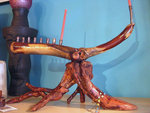 Narrowsburg
NarrowsburgLight Rain Fog/Mist, 43°
Wind: 8.1 mph
 Narrowsburg
NarrowsburgEven though I attended Sunday school religiously and had an extensive Jewish education, I’m still learning. A good example of that comes at this time of year, as we celebrate Hanukkah and the …
Stay informed about your community and support local independent journalism.
Subscribe to The River Reporter today. click here
This item is available in full to subscribers.
Please log in to continue |


Even though I attended Sunday school religiously and had an extensive Jewish education, I’m still learning. A good example of that comes at this time of year, as we celebrate Hanukkah and the Festival of Lights. Growing up, we always lit the menorah, recounted the story of Judah and the Maccabees and the miracle that accompanied the tale of one night’s worth of oil lasting for eight, giving those protecting the Temple enough light to last, keeping the menorah lit long enough to procure more oil and keep it burning in 167 B.C.E.
Honestly, I thought that the menorah was created to commemorate that particular event, and only recently learned that 3,000 years ago, the first menorah was created by Biblical artisan Bezelel, who created a six-branched lamp for use in the first Temple. You can find it described in the book of Exodus, and it was made from one solid block of pure gold (www.jewish art.org).
In the year 70 B.C.E, the Temple was again destroyed, this time by the Romans, who seized the gold menorah, humiliating the Jewish captives. Following that event, the menorah became an important symbol of Jewish history and serves as a reminder of Jewish sovereignty and redemption. Today, Jews celebrate Hanukkah as a commemoration of the Maccabees, and every night for eight nights, we light the candles in the menorah, celebrating the eight-day miracle. Rabbis forbade the use of an exact replica of the original seven-branched menorah, which is why today we light the eight-branched version, called a “Hanukiyah.”
As a child, I saw only one version, with little variety. Made of either gold- or silver-colored metal, the menorah had the requisite eight branches, with the “shamash” in the center, the candle with which the others are lit, often adorned by a symbolic Jewish star. Over the years, however, different interpretations of the traditional have exploded around the world. I sat down with local artist Barry Shavrick, who has been creating menorahs for years, to discuss his creative expression of Jewish history.
“I think I made my first menorah about 38 years ago” Shavrick said. “I learned to weld in Israel, and after I cut my first piece of steel, I knew I’d never do anything else.” Metal worker Shavrick has been at it for decades, and although making menorahs is not the only thing he does, he does it a lot. “I think I’ve made about 300 over the years,” he told me. “And yes, each one is different. Most of them are based on consignment and special orders. You’d be surprised how many people have collections.”
Actually, I wasn’t, because I have friends who collect menorahs, and have seen some amazing, imaginative creations over the years. Just this season, my pals Les and Amy Kristt posted their latest acquisition on social media: a menorah made from hand-hewn wooden beams salvaged from a farmhouse built in the 1700s in Sullivan County. The artist, who “prefers to remain anonymous,” has made her unique creations exclusively available in Monticello at the Funky Hippy Chic Boutique. When I called, proprietor Patti Greco Sunshine said that there were still a few left. For more information on those, call Greco Sunshine at 845/798-1488.
In addition to the styles I ran across this year, I’ve seen menorahs based on cartoon characters, dinosaurs, a harmonica and even my friend Hillary’s riff on vintage Christmas lights—a menorah comprising old-fashioned “bubble lights.” I asked Shavrick if it was all “fair game.”
“Pretty much,” he responded. “They really are, after all, just a different version based on a common theme, and there is nothing wrong with expressing one’s creativity.” Barry returns to Israel yearly with metal artist son Zac (www.zacmax.com), where they conduct workshops and seminars on the art form. “Oh, sure,” Zac chimed in, “there are plenty of our menorah’s on display in Israel, including some very large ones.”
When asked if he derived any spiritual fulfillment from creating them, Barry was thoughtful. “Absolutely” he replied. “I like to think my menorahs are a ‘new take’ on the fragility and delicacy of traditional Judaica [historical materials relating to Judaism], “and Zac has taken the expression to a whole new level. Each one is different, but all reflect the symbol of the original, with a twist.”
To own an original Shavrick menorah, call Barry at 845/701-0009.
Comments
No comments on this item Please log in to comment by clicking here